How Chiropractor Ashli Linkhorn, RKC-II Uses Kettlebells With Her Patients
By Adrienne Harvey, SrPCC, RKC-II, CK-FMS
Dragon Door: How did you first get started in athletics and fitness?
Ashli Linkhorn: I come from a fit family, and played softball and basketball through high school. In college, I played softball for two years and intramurals throughout. After graduating and throughout my professional life I’ve played in adult softball leagues. But as a chiropractor, I found that I was just a little too aggressive when I was playing softball—sliding head first into second, laying out for a ball—so I picked up running. Then I discovered I liked cycling. I didn’t know how to swim, so in 2009, I forced myself to learn how to swim by signing up for a triathlon. Then in 2010, I did my first full Ironman.
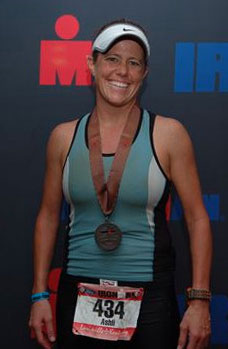
Dragon Door: I’ve heard it’s difficult to learn how to swim as an adult, how was your experience?
Ashli Linkhorn: It absolutely sucked! I had a huge fear of the water, I was afraid of drowning and I didn’t know how to breathe correctly. It took about five different friends helping me before I figured out when and how to take a breath—and that I would be ok!
Dragon Door: And you're a chiropractor?
Ashli Linkhorn: Yes, I am a chiropractor and have an office in Smyrna, Georgia—just outside Atlanta. It's my office but we also have three chiropractors, an athletic trainer, and a massage therapist. I'm also an adjunct faculty member at Life University. And in addition to that, I lecture for the Graston Technique. It's the premier instrument-assisted soft tissue mobilization technique and uses six very specifically designed stainless steel instruments to treat and detect soft tissue dysfunction. So, I wear a number of different hats!
Dragon Door: What brought you to kettlebells?
Ashli Linkhorn: I was rocking my daughter in a rocking chair when she was only a few months old, and I went to stand up, I was kind of stuck in this rocking chair. Since I’m not her birthmother, I wasn’t recovering from giving birth, and I was fit at the time—I could run really far! But, I felt like an idiot because I was struggling to get out of the chair. So that night I went to the store and bought a kettlebell.
I didn't really know what to do with it, but I knew how to squat—and I knew that squatting would help me get out of the chair. Around the same time,
Russ Andrews started to teach Life University—his classes prepare students for my class. We started talking and he told me that his wife,
Beth, would be leading an HKC workshop at their gym in Cartersville.
I decided to attend the
HKC since I wanted to learn the get-up, and because I knew that I didn’t really know how to swing a kettlebell. While kettlebells were not yet part of my practice, I could tell that I might be headed in that direction.
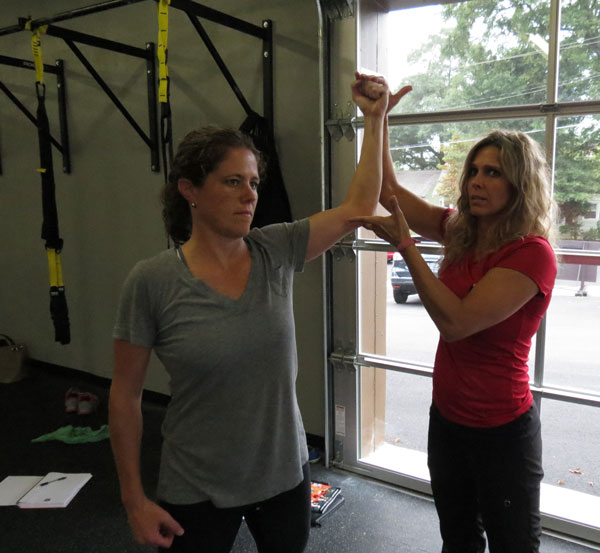
Dragon Door: How did the HKC go?
Ashli Linkhorn: The HKC was really good, though I was a little thick headed. They really had to spend extra time with me so I could learn the hip hinge and how it relates to the swing. I started out really squatty. But since they spent a lot of time coaching me, I was able to figure it out. The HKC was a great experience with great camaraderie. I learned many tips and tidbits to teach someone how to be more body aware—and how to teach the movements and exercises correctly. I liked the HKC a lot and I still use many of the ideas in my office to cue my patients who are learning how to swing.
Dragon Door: And then you not only went on to RKC, but you recently earned your RKC-II! How has that information affected your training and your professional approach?
Ashli Linkhorn: Again, it was kind of like the
RKC and HKC, but with even more tips and tidbits to help me teach the movements. I can now better explain the exercises, too. In my office we use the swing and the
get-up the most, along with the hip grinder. The fixes I learned at the workshops, or while I was preparing for the RKC or RKC-II have made me better in my office.
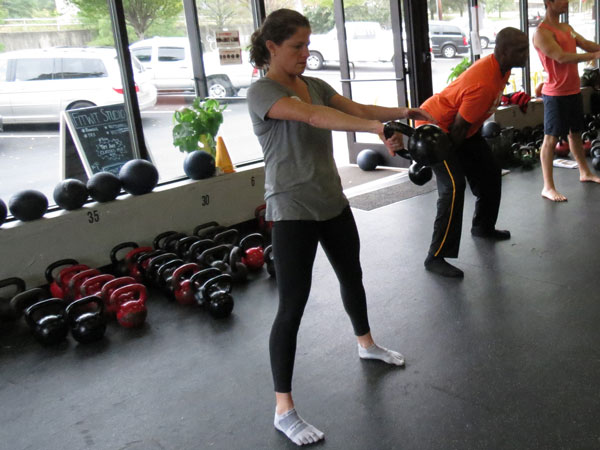
What I’ve learned at the
workshops has helped me communicate with my patients who have predisposed themselves towards inappropriate movement patterns, or who have overdeveloped certain muscle areas in a way that causes a pain pattern. Now, I can teach them alternate exercises and movements that will get their heart rates up, give them a great core, and great glutes.
Dragon Door: Many people will earn their HKC and RKC certifications, but might not feel they have the strength for the RKC-II. How did you prepare and train for your RKC-II?
Ashli Linkhorn: Initially,
RKC Level-II wasn’t really on my radar. When I finished the RKC, I was really pleased with myself and how I’d progressed. Beth Andrews programs all my exercises, and I've been working with her for about two and a half years. After the RKC, she asked what I wanted to do next. I had looked at the RKC-II, but because I've always been an endurance athlete, not a strength athlete, that goal seemed far away.
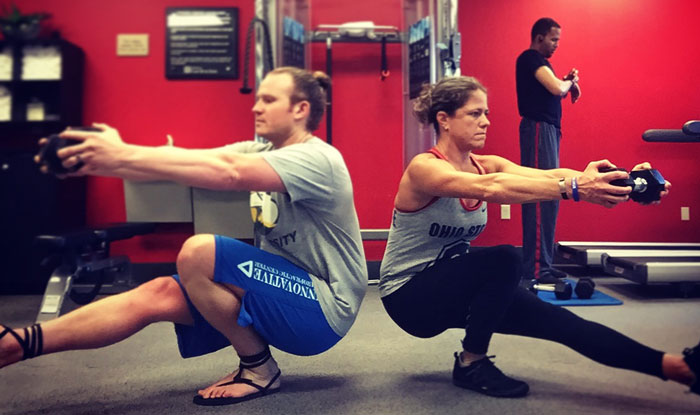
But, I wanted to learn how to pistol because that seemed cool. And I wanted to do
pull-ups and climb on the monkey bars so that when my kid plays on the playground, I can play with her instead of just sitting on the bench. So Beth and I started on that journey. After a while, we saw that an RKC-II workshop was coming to Atlanta. Beth told me I was strong enough for it and that I could do it—and she was right! Full disclosure though, I didn't pass during the workshop because I struggled with the
18kg kettlebell press on test day. But, I was able to nail every other component. Part of me wanted to give up, but I fought through and worked hard afterwards to make sure I could do the 18kg overhead press on video in time to send to
Andrea Du Cane. It was a very interesting journey for me.
Dragon Door: How long did it take you to complete the test?
Ashli Linkhorn: About two and a half months, I ended up having an injury, but Beth helped me "rebuild the machine." While the injury wasn't terrible, it set me back a little bit. I also got stuck in my head a little bit while struggling to get the kettlebell overhead. Then, Beth sent her 18kg
Dragon Door kettlebell over with her husband. She knew that I could press THAT kettlebell overhead. While at first I doubted her, I got it that day. Boom! It went right up overhead. After that, I took the kettlebell home and weighed it! Of course it weighed exactly 18kg. I just had to get out of my head—it was similar to my experiences while learning to swim.
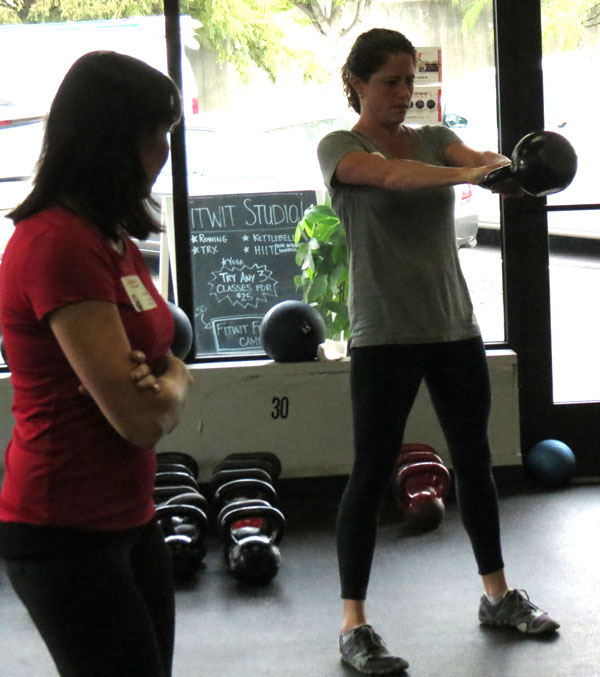
Dragon Door: How are you using kettlebells in your Chiropractic office?
Ashli Linkhorn: They play a huge role in a lot of our rehab. We do a lot of heavy farmer carries. I think that men and women should be able to do heavy farmer carries. We teach many of my shoulder patients how to do rack carries, too. And we do a lot of Turkish get-ups. One of my favorite patients is well into her 60s and is doing really beautiful get-ups—I love it!
Many of my athletes are doing kettlebell swings because swings have the same explosiveness needed in sports, especially if you're a pitcher, a tennis player, or a golfer. We do kettlebell drags, which I learned at the RKC level one, I think it is a brilliant exercise. Of course, we are constantly patterning the
hip hinge and doing a lot of hip grinders, Cossack squats, and ankle dorsiflexion drills. So, kettlebells are playing a big part at the office.
Dragon Door: What's next for your own training?
Ashli Linkhorn: Beth and I were just talking about that. I like being strong. It’s funny but sometimes when I’m washing my arms in the shower I think, "Whose arms are these?" Because before kettlebells, I'd never had arms like this! They’re not huge, but they’re round and defined—and that’s definitely not how they used to be! So, I told Beth that one of my goals is to keep these shapely arms! But, my biggest priority is being able to play with my 4 year old daughter. There were a lot of push presses in my workout today, I like them because they’re really similar to the same movement as when I’m in the pool tossing my daughter up in the air. And of course I still want to climb on the monkey bars with her.
Recently she came to the office with me when I doing paperwork and not seeing patients. While we were there, I tried to do a pull-up with her hanging on to me, which I couldn’t quite do, so that might be a goal. I have already done a get-up with her on my arm. My goals are to be able to play and be strong.
Dragon Door: Do you have any athletic events coming up?
Ashli Linkhorn: I don't, but I still get up every morning and run about four miles with my dogs. So, if I wanted to do a 5 or 10k on any day, I am ready.
In my house there are two things we always talk about, the first one is "be tall" and it means a couple of things, certainly it means no slouching. It’s also about being confident, be tall! The second thing we say a lot is "lean in"—don't hold back, put all of yourself into what you're doing. That idea is about following through with action. "Be tall," you’re confident, now "lean in," make things happen.
Something Beth and I have talked about is that as a woman, it is absolutely ok to be strong. We should not accept portraying ourselves as weak or as needing to be weak. We should be confident in who we are—and in our abilities. Of course it’s also important to be humble.
At my RKC-II it was really cool how the other females in the group were super uplifting. After Andrea approved my press, I posted the video on Facebook, and the two girls who were at the RKC-II commented to the other one, "Hey look, it's our girl!" I thought that was really awesome—it felt like we were part of a family.
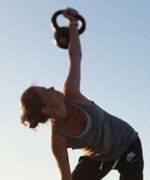 Ashli Linkhorn, RKC-II, is a Certified Chiropractic Sports Practitioner, Certified Chiropractic Extremity Practitioner, PES/CES – NASM, FMS Level 1 Certified & 2, SMFA Certified, TPI Certified, and Graston Technique Instructor. Learn more about her office, Sports Chiropractic Institute: sportschiropracticinstitute.com
Ashli Linkhorn, RKC-II, is a Certified Chiropractic Sports Practitioner, Certified Chiropractic Extremity Practitioner, PES/CES – NASM, FMS Level 1 Certified & 2, SMFA Certified, TPI Certified, and Graston Technique Instructor. Learn more about her office, Sports Chiropractic Institute: sportschiropracticinstitute.com
Back